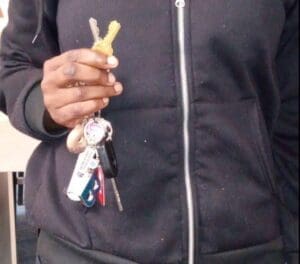
New Castle County will issue a report next year to detail more facts about the homeless people they’ve served at the Hope Center. Photo by Kyle Grantham/New Castle County
As homelessness increases in Delaware and COVID-related support dries up, the New Castle County Hope Center plans to roll out its new long-term sustainability strategy in January.
It will include a companion dashboard demonstrating how big a dent in the problem the center has made over the past three years.
New Castle County purchased the former Sheraton Hotel on Airport Road off I-95 in early December 2020 for $19.5 million from its share of federal CARES Act funding.
Two weeks later, it reopened the 192-room hotel as a temporary emergency shelter to protect homeless state residents from winter weather and the coronavirus.
But federal COVID support largely went away on Oct. 1, 2022.
Carrie Casey, general manager of the county’s Department of Community Services, says funding worries keep her awake at night as she looks to plug gaps in her $5 million annual budget.
New Castle County does not provide operational support.
“We may charge $50 a night,” Casey said, “but the total cost including shuttle transportation, security, building costs and staffing, engineering, maintenance, case management, and pet care is about $80 a night.”
Now, the East Coast’s largest homeless shelter is helping families find permanent housing by tying the length of their stay to active participation in its programs.
Those include seeking employment, attending substance-abuse meetings and medical appointments, meeting curfews, and treating center employees with respect.
“We have kind of built the airplane in the air,” says Casey.
But this airplane lacks sufficient onboard data to understand basic metrics.
For example, more than 3,200 people have spent at least one night at the Hope Center, with 325 households finding permanent housing after getting back on track.
Casey struggles to provide information on total room nights or how many people have moved into some kind of permanent housing.
During the COVID pandemic, the Hope Center had 450 people in the building at any given point, but today’s numbers are closer to 300-350.

This New Castle County Hope Center resident achieved her goal of moving out of the center into her own place.
Hope Center successes
Help is on its way early next year when the county completes a dashboard that it will use to share the center’s impact with other municipalities and potential donors.
Anecdotally, the Hope Center has:
- Leased the entire sixth floor to ChristianaCare, which offers a full-service doctor’s office for residents and operates a program for outpatients who need to rest and recuperate but don’t have a place to go. ChristianaCare contracts for 36 rooms per night for $50 each, regardless of whether they’re used.
- Secured a commitment from DART to start operating a bus stop at the Hope Center in May 2024. This will supplement the Hope Center’s daily shuttle to Prices Corner and distribution of bus passes to residents.
- Obtained a second $10,000 grant from Uber to help participants handle daily needs and errands.
- Increased the number of partner organizations that refer unhoused people to the Hope Center to about 20.
- Implemented an enrichment program for school-age children in partnership with the United Way that assists with educational needs and field trips to places like the White House and Longwood Gardens.
- Partnered with Faithful Friends to provide comprehensive care to pets living at the Hope Center, which is the only shelter in Delaware to allow pets.
New Castle County Executive Matt Meyer said he never would have imagined the support from Hope Center partners and the community after the county bought the Sheraton.
“As we move past the original mission,” he said, “I look forward to working with those same stakeholders on the Hope Center’s future.”
The state’s Congressional delegation secured $750,000 in federal funds in June 2023 to fix a section of the center’s roof (work should start 1Q 2024) and to help with transportation costs. It is also pursuing what the delegation calls “crucial federal funding” for homeless initiatives in Delaware, including the Hope Center.
Between the opening and Sept. 30, 2022, pandemic relief money enabled families to stay at the center for more than a year.
IN THE NEWS: Wilmington Learning Collaborative will focus on setting up programs, not expansion
The loss of that funding has county officials searching for ways to bridge the funding gap left by $50-per-day Division of State Service Center Emergency Motel vouchers carrying a maximum payout of $1,200 – enough for about 24 days.
“We feel if we could give them 90 days, we could resolve their homelessness,” Casey says.
“We’re able to keep families together,” Casey says. “We serve all different types of populations — single males with children, multi-generational families, people who need accessible units, families with children older than 18. We are the only shelter in the state that can serve families of nine because we have 10 rooms that adjoin another room. We’ve had 27 newborns call the Hope Center their first home.”
The Hope Center also provides on-site support services, including a rotating group of case managers and volunteers from state and local organizations.
The State operates “Bridge Clinic” across the state whose services include screening and referrals to treatment for mental health and substance use disorders and access to on-site licensed clinicians. The one at the Hope Center operates seven days a week.
Casey’s $80 a night does not include in-kind services offered by Christiana Care and the State of Delaware.
The Division of Substance Abuse and Mental Health, the Division of State Service Center, and the Division of Social Services all operate offices in the building.
By contrast, the National Alliance to End Homelessness reports that a chronically homeless person costs the taxpayer an average of $35,578 per year.

A small ceremony marked a Hope Center mutual understanding agreement between U.S. Housing and Urban Development and New Castle County.
Reducing homelessness gap
At any given time, the Hope Center is sheltering about a quarter of the people experiencing homelessness in the state, said Rachel Stucker, executive director of Housing Alliance Delaware.
“The Hope Center doesn’t put people back out on the streets just because they time out,” she said. “A lot of shelters limit how long you can stay, regardless of whether they have somewhere safe to go. The Hope Center doesn’t do that. That is a model for what I hope other folks will start looking at when someone doesn’t have anywhere safe to go without starting the process all over again somewhere else.”
Some homeless issues reflect the gap in affordable housing for low-income people of more than 21,000 units, according to a 2023 survey by the National Low Income Housing Coalition.
“That’s significant,” says Stucker. “For each of the units we don’t have, there’s a person or a family living somewhere else, whether that’s a homeless shelter, a car, the street, or in a rental unit somewhere paying way more than they can afford and struggling to make ends meet every day.”
At one point, 30% of the Hope Center’s residents were from Kent and Sussex County.
Casey said the sustainability plan will include efforts to encourage different jurisdictions to provide additional funding.
In addition, a new DART stop will reduce the cost of providing the shuttle to Prices Corner
“I am so incredibly grateful to DART and Uber for seeing the need to get people to doctor’s appointments, job interviews, housing appointments and school or work,” she says.
Casey also hopes the Hope Center’s long-term plan will consider dedicating a floor to lease “supportive housing” to some current residents who have been homeless for years or have a disabling mental or physical condition, rather than sending them back out on the street.

New Castle County spent $19.5 million from its federal CARES Act funding to buy the Sheraton Hotel on Airport Road in December 2020. The ocunty doesn’t provide operational funding.
Cold weather demand rises
Both Casey and Stucker said demand will increase as the weather gets colder and people experience more financial stress.
Stucker said her organization’s crisis hotline is seeing a steady increase in the number of calls and emails and texts from people who are sleeping in their cars, sleeping outside, facing eviction, or having to leave where they’re staying.
“Yesterday, more than 150 people called us looking for some type of shelter and housing help, but we only had six open emergency shelter beds across the state,” Stucker said a few days before Thanksgiving. “All the rental assistance available during COVID is gone. There are very few options for help.”
Stucker believes the Hope Center’s model can be replicated elsewhere.
“There’s no reason we can’t have more non-congregate shelters (individual family units rather than a roomful of beds) like the Hope Center for people who are housing insecure and homeless and need privacy, a place to keep their documents safe, and accommodate people with service animals and pets without a problem.
“It just requires investment like what New Castle County did.”
Peter Osborne is the former editor of the Delaware Business Times and is a consultant who helps clients with their branding, positioning, and sales-communications efforts.
Share this Post




